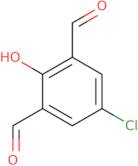5-Chloro-2-hydroxybenzene-1,3-dicarbaldehyde
CAS: 32596-43-3
Ref. 3D-HBA59643
| 1g | Descontinuado | ||
| 25mg | Descontinuado | ||
| 50mg | Descontinuado | ||
| 100mg | Descontinuado | ||
| 250mg | Descontinuado | ||
| 500mg | Descontinuado |
Informação sobre produto
- 1,3-Benzenedicarboxaldehyde, 5-chloro-2-hydroxy-
- 2,6-Diformyl-4-Chlorophenol
- 2-Hydroxy-5-chlorobenzene-1,3-dicarboxaldehyde
- 2-Hydroxy-5-chloroisophthalaldehyde
- 4-Chloro-2,6-diformylphenol
- 5-Chloro-2-Hydroxybenzene-1,3-Dicarbaldehyde
- 5-Chloro-2-hydroxy-1,3-benzenedicarboxaldehyde
- 5-Chloro-2-hydroxybenzene-1,3-dicarboxaldehyde
- Isophthalaldehyde, 5-chloro-2-hydroxy-
- 5-Chloro-2-hydroxyisophthalaldehyde
- Ver mais sinónimos
5-Chloro-2-hydroxybenzene-1,3-dicarbaldehyde is an organic compound that is used as a control experiment for crystallographic data. It is a coordination complex of the type known as a chelate with metal ions such as lanthanum and europium. The compound has been shown to have physicochemical properties that depend on its coordination number and the nature of the metal ion it binds to. 5-Chloro-2-hydroxybenzene-1,3-dicarbaldehyde shows tetranuclear clusters when coordinated by lanthanum or europium ions. This compound can also form mononuclear clusters with other metals such as copper or nickel.





